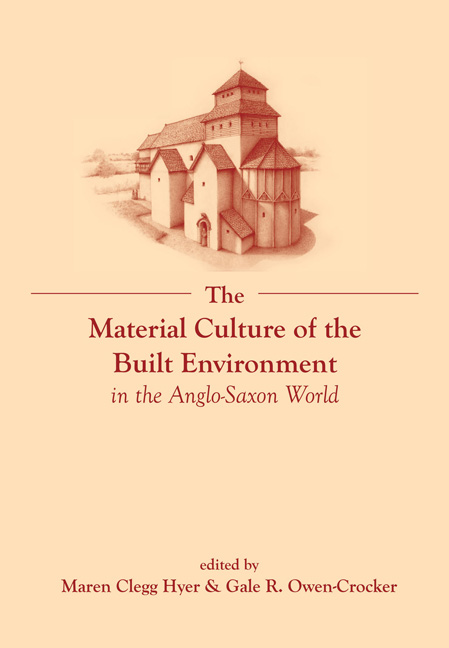Book contents
- Frontmatter
- Dedication
- Contents
- List of Figures
- List of Tables
- List of Contributors
- Introduction
- 1 Enta geweorc: The Ruin and its Contexts Reconsidered
- 2 Roads and Tracks in Anglo-Saxon England
- 3 Domestic Dwellings, Workshops and Working Buildings
- 4 Place and Power: Meetings between Kings in Early Anglo-Saxon England
- 5 The Cuckoo and the Magpie: The Building Culture of the Anglo-Saxon Church
- 6 Landmarks of Faith: Crosses and other Free-standing Stones
- 7 Landmarks of the Dead: Exploring Anglo-Saxon Mortuary Geographies
- 8 Boundaries and Walls
- 9 The Landscape of Late Saxon Burhs and the Politics of Urban Foundation
- 10 Signalling Intent: Beacons, Lookouts and Military Communications
- Notes
- Suggested Reading
- Index
3 - Domestic Dwellings, Workshops and Working Buildings
- Frontmatter
- Dedication
- Contents
- List of Figures
- List of Tables
- List of Contributors
- Introduction
- 1 Enta geweorc: The Ruin and its Contexts Reconsidered
- 2 Roads and Tracks in Anglo-Saxon England
- 3 Domestic Dwellings, Workshops and Working Buildings
- 4 Place and Power: Meetings between Kings in Early Anglo-Saxon England
- 5 The Cuckoo and the Magpie: The Building Culture of the Anglo-Saxon Church
- 6 Landmarks of Faith: Crosses and other Free-standing Stones
- 7 Landmarks of the Dead: Exploring Anglo-Saxon Mortuary Geographies
- 8 Boundaries and Walls
- 9 The Landscape of Late Saxon Burhs and the Politics of Urban Foundation
- 10 Signalling Intent: Beacons, Lookouts and Military Communications
- Notes
- Suggested Reading
- Index
Summary
You [King Edwin] are sitting feasting with your ealdormen and thegns in winter time; the fire is burning on the hearth in the middle of the hall and all inside is warm, while outside the wintry storms of rain and snow are raging; and a sparrow flies swiftly through the hall. It enters in at one door and quickly flies out through the other. For the few moments it is inside, the storm and wintry tempest cannot touch it, but after the briefest moment of calm, it flits from your sight, out of the wintry storm and into it again. So this life of man appears but for a moment; what follows or indeed what went before, we know not at all.
Introduction
In this celebrated passage, one of King Edwin's retainers describes (if only in passing) the importance of buildings in the Anglo-Saxon period. Not only did such structures provide the setting for domestic life, but they also were a refuge from elements outside: in the words of Le Corbusier, they were ‘a machine for living in’. Although most Anglo-Saxon domestic structures were usually less impressive than their ecclesiastical counterparts, particularly later stone churches, they were much more fundamental to life (Figure 3.1). The following will examine these ‘machines’ and consider how they might have fulfilled the many needs and demands of human existence, including shelter, warmth, security, storage, catering and cultural life and how they served as a workspace.
Climate and environment
A building's form is, to a large extent, determined by the environment in which people live; heat, cold and wet predicated the type of structures needed in Anglo-Saxon times. Britain had enjoyed an equitable climate during the Roman period, as conditions were warmer and drier than those experienced at present and allowed an expansion of agriculture onto low-lying, poorly drained land. This changed during the early fifth century with a fall in mean temperature and increased wetness and flooding. These environmental pressures also affected mainland Europe and played a part in triggering the migrations which brought the Anglo-Saxons to Britain. The climate improved and by the eighth century England seems to have had a more ‘continental’ type environment, with drier and warmer summers but hard winters.
- Type
- Chapter
- Information
- Publisher: Liverpool University PressPrint publication year: 2015



